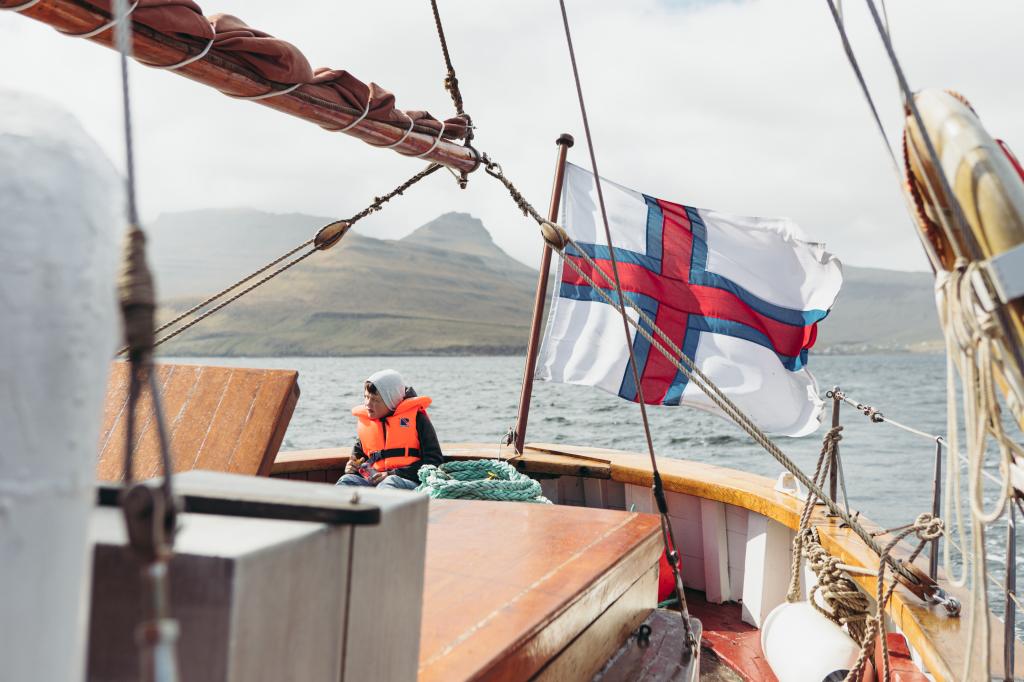THE FAROESE FLAG
The flag of the Faroe Islands is an offset cross, representing Christianity. It follows the traditions of other Nordic flags, such as the Dannebrog (Flag of Denmark).
The flag is called Merkið, meaning “the banner” or “the mark”. It was designed in 1919 by Jens Oliver Lisberg and other students in Copenhagen. The first time Merkið was raised in the Faroe Islands was on 22 June 1919, in Famjin, the home village of Mr. Lisberg, during a wedding.
On 25 April 1940, the British government, occupying the Faroe Islands during World War II, approved the flag for use by Faroese vessels. April 25 is still celebrated as Flag Day (“Flaggdagur”) and is a national holiday. The Danish Government finally recognized Merkið as the national flag of the Faroe Islands in the Home Rule Act of 23 March 1948. The original flag is displayed in the church of Famjin on the island of Suðuroy.
THE ORIGINAL FLAG ON DISPLAY
THE HISTORY OF ‘MERKIÐ’, THE FAROESE FLAG
Like other countries, the Faroese have a story to tell about their national flag. Despite its youth, the flag has an eventful story, indicative of the Faroese spirit.
The Faroe Islands have been part of the Kingdom of Denmark for many centuries. During these years, the official Faroe Islands flag was ‘Dannebrog’, the Danish flag. In the 19th century, the Faroese created their first flag. It included an insignia of a Faroese ram and a ‘tjaldur’ (oystercatcher), the national bird of the Faroe Islands. This flag was used during occasions and public gatherings but was never recognised as the official flag of the Faroe Islands.
Jens Oliver Lisberg, Janus Øssursson and Paul Dahl were Faroese students studying in Copenhagen at the start of the 20th century. They felt it was inappropriate for the Faroese to use an unrecognised flag during celebrations and times of sorrow. Using ‘Dannebrog’ undermined the Faroese nation, they thought. They took matters into their own hands and designed a new version of the Faroese flag that included the Nordic cross and the colours red, white, and blue. The red and blue are endemic in traditional Faroese clothing and consider the islands’ close connection to Iceland and Norway, whose flags also bear these colours. The white background symbolised waves breaking onto the Faroese shores.


‘Merkið’ was raised for the first time in June 1919. The same year, a youth organisation called ‘Merkið’ was founded. Their goal was to get the new Faroese flag recognised. In the following years, sailing vessels were reported to the police and denied sailing rights by the Danish government for showcasing ‘Merkið’. As more and more sailing vessels hoisted the Faroese flag, the number of flags seen on land increased. This angered the Danes. In 1930, on the 1000th anniversary of the Icelandic parliament, the Danish prime minister ordered the Faroese flag be lowered and removed. This proved to be the last straw for many Faroe Islanders. Protests followed. The Danish flag was taken down outside the Faroese parliament, the Løgting. The protesters were arrested and fined for their illegal actions. However, their actions were not in vain. This event was a critical moment in the independence movement that followed.
World War II played a role in the emergence and adaptation of the Faroese flag. Germany occupied Denmark, and the British peacefully occupied the Faroe Islands. The Faroese, supported by the Faroese parliament, were naturally afraid to sail under the Danish flag. This was met with opposition from the Danish governor, who insisted that the islanders use the Danish flag.
The British occupation of the islands meant the British consul had the last word. He considered ordering the Faroese to sail under a green flag with a white cross.

On April 25, 1940, the British government officially recognised ‘Merkið’ as the official marine flag of the Faroe Islands.
In the end, he acknowledged the protests of the islanders in the streets of Tórshavn. On April 25, 1940, the British government officially recognised ‘Merkið’ as the official marine flag of the Faroe Islands. This marks one of the most critical dates in Faroese history.
The news, aired on the BBC in all major world languages, made its way to all corners of the world.
After World War II, discussions regarding the flag occurred between the Faroe Islands and Denmark. Danish authorities reluctantly gave in to recognising ‘Merkið as the national flag of the Faroe Islands, not only at sea but also on land. This was established in writing in the Home Rule Act of 1948.
Since 1948, April 25 has been celebrated annually as Faroese Flag Day, a national holiday.
THE NATIONAL ANTHEM
The national anthem of the Faroe Islands is called Tú alfagra land mítt, which means "Thou fairest land of mine". It was written in 1906 by Símun av Skarði, the headmaster of a high school southwest of Klaksvík. At that time, the Faroe Islands were divided between the conservatives, who wanted to maintain Danish rule, and the autonomists, who wanted more self-government.
The first notes of the music were written by a violinist named Petur Alberg in 1907. He sang the melody over the phone to Símun av Skarði, who liked it. At a concert in Tórshavn the same year, Petur did not reveal who the song's author was and instead told the singers that it was an Icelandic song. Nevertheless, the singers liked the song, and it was performed publicly for the first time on December 26, 1907.





